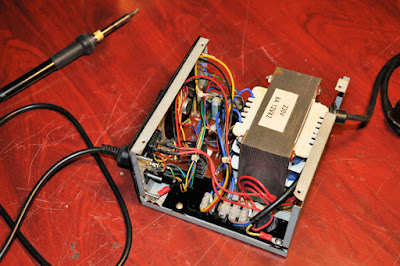HAKKO 907 is popular and commonly available soldering iron in the electronics field. To drive those soldering irons user needs to have HAKKO or any other compatible soldering station. The biggest problems with those soldering stations are there higher price tags and limited availability in the local market.
Because of those problems, we decided to create our own soldering station, and for that, we choose "Chinese" version of HAKKO 907 soldering handle. Now Chinese versions of 907 compatible irons are available on eBay for less than 5USD. As per our observations, those Chinese versions of soldering irons look and perform almost similar to genuine HAKKO 907 iron(s).
To keep it simple we choose LM358 dual operational amplifier IC to monitor the 907's thermocouple and drive the TRIAC. The entire control circuit of this soldering station is powered by single rail 5V DC power supply. To drive both handle and station we use 12V-0-12V 8A step-down transformer.
Once calibrated, we may be able to regulate the temperature of the soldering iron between 210 °C to 450 °C. As shown in the photograph we construct our final version of soldering station in slightly modified old ATX power supply casing. For this entire project, we spent the only 25USD, which is roughly 3000LKR at the time of writing.
Schematic, PCB design and wiring diagrams related to this project are available to download at google drive.
Because of those problems, we decided to create our own soldering station, and for that, we choose "Chinese" version of HAKKO 907 soldering handle. Now Chinese versions of 907 compatible irons are available on eBay for less than 5USD. As per our observations, those Chinese versions of soldering irons look and perform almost similar to genuine HAKKO 907 iron(s).
To keep it simple we choose LM358 dual operational amplifier IC to monitor the 907's thermocouple and drive the TRIAC. The entire control circuit of this soldering station is powered by single rail 5V DC power supply. To drive both handle and station we use 12V-0-12V 8A step-down transformer.
 |
| Internal view of finished soldering station. |
Once calibrated, we may be able to regulate the temperature of the soldering iron between 210 °C to 450 °C. As shown in the photograph we construct our final version of soldering station in slightly modified old ATX power supply casing. For this entire project, we spent the only 25USD, which is roughly 3000LKR at the time of writing.
Schematic, PCB design and wiring diagrams related to this project are available to download at google drive.
Comments
Soldering iron
Sky Flight Rc Jet
kerui Security alarm
weller soldering
Flightline RC Plane